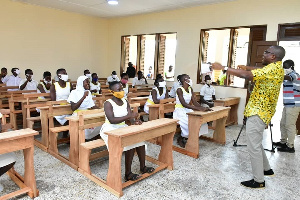Exploring the potential for citizen participatory practices in environmental decision-making in mining communities in Ghana

Ghana’s accession to global environmental decision-making dates back to 1924, well before the country attained independence from British colonial rule in 1957. However, it was not until 1971 that the first Multilateral Environmental
Agreement (MEA) was ratified, with the objective of creating international offices to control contagious diseases found mostly in animals.
The transition from three fitful military regimes to a more stable constitutional democracy in 1992 has provided Ghana with the ‘fertile ground’ to participate in decision-making at international levels.
For example, environmental decision-making at the country level took a positive turn in 1994 following the enactment of the Environmental Protection Agency (EPA) Act (ACT 490) to replace the 1974 Environmental Protection Council (EPC) decree, which was but an advisory body with a limited role to make decisions on environmental matters.
Unlike the EPC, the EPA was not only established to provide a broad range of environmental advice to decision-makers, but also to make decisions that affect the environment, see to their enforcement, and conduct Environmental Impact Assessment (EIA) on activities that could negatively impact the environment.
The EPA was established in line with the 1992 Rio Declaration to which Ghana is a signatory, and its comprehensive action plan under the AGENDA 21 programme, which requires countries to cooperate to take action on environmental and development issues and to undertake EIA of all proposed environmental activities that are likely to affect the people and the environment.
Other agreements include the 2015 Paris climate change agreements (COP15), and the twenty-sixth (COP26) sessions of the conference of the parties to the Paris climate change agreement in Glasgow, to which Ghana submitted its updated Nationally Determined Contributions (NDCs) for the 2020 to 2030 period as part of the country’s pledge to undertake various environmental activities to address the impact of climate change on the economy and its vulnerable citizens.
In addition to this, Ghana also signed on to several regional environmental agreements, including the revised African Convention on the Conservation of Nature and Natural Resources, and the African Mining Vision (AMV), which seeks to provide a framework for sustainable mining to address potential social challenges such as the “poverty paradox” commonly associated with countries rich in natural resources, and the 2003 Revised Maputo Convention, which seeks to crystalise the continent’s response to global issues on the environment and to promote collaboration among states to address environmental concerns under the Common but Differentiated Responsibility (CBDR).
The CBDR establishes a principle in international environmental law, that allows countries to take coordinated action to address environmental issues by leveraging on the experiences of other countries. On the bilateral level, Ghana also signed the 1999 Minamata Convention on Mercury to control the importation, sale, and use of mercury in gold mining.
Despite Ghana’s active participation in international environmental agreements, their implementation at the domestic level has remained ineffective over the years partly due to factors such as inadequate qualified personnel, bureaucratic and administrative procedures, lack of clarity relating to the role of the EPA, the non-binding nature of environmental agreements and institutional fragmentation.
The 1992 constitution of Ghana provides for a broad spectrum of legislation that guides different facets of domestic policymaking, including the environment. Under this law, the power to negotiate and sign treaties is the prerogative of the president. However, the power to ratify international treaties is the duty of parliament.
As a result, any bill seeking to implement an international agreement must first originate from the president’s cabinet, which is then forwarded to parliament for ratification after which a copy is deposited at the embassy of the host country for further transmission to the depository under which the agreement falls. This process can take approximately six months, making it difficult for the prompt implementation of international environmental agreements at the country levels.
Another notable challenge is the constitutional architecture of the country. Ghana operates the common law system of Britain, which require that domestic laws or policies must first be made to give effect to the agreements accented to at the international level.
In Ghana, such processes will require the introduction of new legislative bills from the executive arm of government, which has budgetary and cost ramifications for the country, and in most cases, it could take several years for the bill to be approved by parliament.
However, these challenges are not akin to Ghana alone. Other impediments to environmental decision-making globally include the complex nature of the issues, the multiple actors involved, as well as their cross-border nature, and the trade-off arising from economic externalities over environmental concerns. Environmental decision-making usually conflicts with other interests, say, profit-making, which could impede effective environmental decision-making.
For example, while environmental activists may demand industrial reduction in carbon (CO2) emission, producers and other market forces could view such demands as detrimental to profit making.
In addition to this, there is also a lack of clarity regarding the proper definition of what constitutes environmental issues. Dale and English argued in their book, Tools to aid environmental decision-making that, all human activities have environmental consequences which require decisions to be made on.
However, some human actions, albeit their consequences on the environment, can be considered as having an indirect impact because of their profit and job values.
For example, the decision to build a baseball stadium can be conceived as a human preference, but it can also raise concerns over land use and transportation. Similarly, the mining of natural resources such as gold serves as a source of wealth to both families and the state irrespective of its negative environmental impact on critical resources such as water and land.
Unlike decision-making relating to issues such as the siting of waste plants which may affect a small group of people, environmental issues such as air pollution or gold mining can affect everyone, including those outside of the city where the pollution originates.
To a large extent, environmental issues are socially constructed—they are society’s collective consciousness which can differ depending on the locality and actors involved. This explains why some environmental issues may require urgent decision-making while others may take a longer time for decisions to be made.
For example, environmental decision-making relating to air and water-quality management, waste management, and natural resource protection may require urgent decision-making because of their potential wider impact on society.
However, decision-makers often missed the mark by not identifying specific issues that turn to impede environmental decision-making outcomes.
Dale and English noted four components of environmental decision-making that stakeholders should consider when making environmental decisions. They include the type of issue to be discussed, the participants to engage, the setting, and the period for making the decision. According to them, these components would serve as a guide for decision-makers to effectively identify the “gaps and blinders” in the decision-making process.
To that end, my research will draw on these components to explore the potential for citizen participatory initiatives such as consultation, citizen assemblies, referenda and elections, participatory theatres, and other useful innovative participatory mechanisms, to elicit environmental decision-making relating to artisanal small-scale gold mining (ASGM) in Ghana, which for the past years has become a major concern to policymakers, civil society groups, the media, and residents of mining communities.
Gold mining is broadly defined as the process of extraction, beneficiation through ore enrichment, and the processing of solid materials from the earth’s crust either through open quarrying or underground excavation. The artisanal small-scale mining (ASM) sector has witnessed significant growth over the years due to two major reasons.
To begin with, the sector has become an important route for people in the world’s poorest countries to navigate their way out of poverty by generating small incomes due to a lack of employment opportunities. Secondly, the price value of gold has soared globally, making the sector attractive for wealth creation. The definition of ASM depends on the type of tools used, and their effect on the environment.
Globally, it is estimated that the sector saw an increase from six million people in 1993 to 13 million in 1999. However, the Intergovernmental Forum on Mining, Minerals, Metals, and Sustainable Development (IGF) estimated that the sector further expanded from 30 million in 2014 to 40.5 million people in 2017. Currently, an estimated 150 million people, mostly from approximately 80 global south countries including Ghana, Mali, Kenya, Tanzania, Bolivia, and Peru are engaged in ASM, compared to only seven million people working in the large-scale mining sector.
The sector’s share of global mineral production has also increased over the years, contributing to 20% of the global gold supply, 26% of the world’s tantalum production, and 25% of the world’s tin coming from ASM.
In Africa, the sector is dominated by artisanal small-scale gold mining (ASGM). It is estimated that 80% of ASM miners operate informally, and this also underpins their poor performance and traps most community members in cycles of poverty which deprived them of access to legal support. Some have argued that to deal with the ASGM menace, the sector needs to be formalised to include the views of ASM operators in decision-making.
There are indicative reasons for the large public participation in ASM in Sub-Saharan Africa. To begin with, the sector’s burgeoning is motivated by the desire to grow wealth. Compared to commercial farming, it is estimated that ASM generates an average minimum wage earning of $3 a day, while agriculture only provides about $0.6 daily earnings.
In addition to this, mining is an all-year-round activity compared to farming which is seasonally bound.
In Ghana, artisanal small-scale mining is known in local parlance as “galamsey,” which means to ‘gather and sell’. Unlike large-scale mining (LSM) which is licensed and usually involves the use of sophisticated mining equipment such as excavators and mining explosives, ASM exists in two forms: it includes licensed and unlicensed operations. Both the LSM and the ASM sectors are regulated by the minerals and mining Act, (ACT 703) of 2006, whilst the unlicensed ASM operation is informal and unregulated.
The minerals and mining Act (ACT 703) of 2006, as amended by the minerals and mining (Amendment) Act, (ACT 900) of 2015, and the minerals development fund Act, (ACT 912) of 2016, are the main mining laws of Ghana. These laws provide for a wide range of legislation, including the procedures to apply for mining concessions, as well as the acquisition of mining licenses.
The minerals commission, the EPA, and the Ministry of Lands and Natural Resources (MLR) are the key regulatory institutions of the mining sector in Ghana. In Ghana, the unlicensed ASM or ‘galamsey’ operation is illegal.
The practice is labour intensive and requires the utilisation of rudimentary tools such as shovels and pickaxes to dig the gold from the underground. In addition, the sector is predominantly artisanal small-scale gold mining. The ASGM operators also rely on the use of dangerous chemicals such as mercury to separate the gold from its ores leading to serious health hazards.
At present, most ASGM operators do not have a license to mine as required by law largely due to factors such as corruption, clientelism, regulatory capture, long and cumbersome license processing times, and exorbitant licensing fees.
Besides cocoa and oil, gold is one of the major export earners for Ghana, with gold production dating back to some 1,000 years. According to available data from the Ghana Chamber of Mines and the Ghana statistical service, the mining sector alone contributed 12% to the country’s Gross Domestic Product (GDP) in 2021, compared to Cocoa with just 1.9% and Oil and gas with 4.6%.
It is estimated that ASM accounts for an estimated 30% of gold production in Ghana.
In addition to this, an estimated four million households depend on ASM for their livelihood. It is further estimated that the sector employs some 1 million people including foreigners, making Ghana the second country in Africa after Tanzania with the largest number of ASM employees in 2016.
A recent study conducted by a team of researchers from the University of Surrey in some three sub-national regions in Ghana shows that Covid-19 had little or no impact on ASGM activities. Out of the 263 respondents drawn from greater Accra, Eastern, and the Ashanti regions, 81% said their mining activities were not in any way affected by restrictions imposed by the government during the pandemic.
Yet, despite the significance of the sector to wealth creation, mining communities remained largely poor, with a lack of access to basic social amenities and education.
The ‘galamsey’ activities have equally raised serious environmental, health, and safety (EHS) concerns. On environmental-related issues, ASGM activities have led to forest degradation and water pollution. It is estimated that approximately 30000 hectares of forest have been destroyed by ASGM activities between 2015 and 2018.
Healthwise, the use of mercury in mining is leading to an increase in mental health cases in some mining communities, whilst safety concerns have been raised over open pit galamsey mines which poses risk to death for residents. Recent reports by the Ghana health service (GHS) have shown that the outbreak of the Marburg virus in some mining communities is due to open galamsey pits which have become the home to bats and rodents—the main carriers of the virus.
In some mining communities, it has been reported that ASM activities have led to violent confrontations between ASGM miners and LSM companies and security forces stationed in these communities.
In 2017, the government took a decision to ban ASGM activities for six months after an Accra-based radio station Citi FM launched a campaign against illegal mining operations in the country. Government intervention includes the deployment of military personnel to illegal mining areas to clamp down on operators. Data available shows that a similar strategy known as “operation mercury”, used by the Peruvian government to discourage illegal mining in the Peruvian Amazon forest during the same period has led to a 90% decline in gold mining deforestation.
However, given the economic impact on the people, concerns have been raised that ‘operation mercury’ only created an opportunity for illegal miners to relocate to new mining areas. In Ghana, the ban on both legal and illegal artisanal small-scale mining lasted for two years, leading to worsening living conditions for families that depend on ASM for their livelihoods, loss of jobs, and a reduction in income levels for poor families.
According to the Water Resource Commission (WRC), nearly 60% of water bodies have been polluted by illegal miners, prompting the ministry of defence to warn that Ghana risk importing water by the year 2030 if the trend continues. Recent reports also suggest that more than 40% of mental health cases in communities such as Obuasi are due to the release of mercury in water bodies.
Recently, the government took a decision to eliminate the use of mercury in mining by providing ‘mercury-free’ mining equipment to licenced ASM operators. This seeks to operationalise the implementation of the 1999 Minamata Convention on the use of mercury in mining. Yet, the enforcement of mining regulations has remained ineffective due to factors such as regulatory capture, political interference, and weak institutional and management capacity at the local government levels.
Given the above, my research will seek to explore the potential for citizen participatory initiatives by examining innovative ways of involving key stakeholders such as government representatives, community members, and other non-state actors such as civil society groups, and the media in environmental decision-making to address the challenges with artisanal small-scale mining of gold in Ghana.
There are four potential goals for this research. They include a) exploring citizen participatory initiatives across liberal and constitutional democracies, and determining how this could be applicable in Ghana; b) examining the decision-making mechanisms in Ghana drawing on the institutional and governance frameworks; c) exploring various environmental decision-making mechanisms, and drawing on useful lessons from the Organisation for Economic Cooperation and Development (OECD) member countries; and d) review innovative participatory mechanisms, their success and challenges to determine how such mechanisms could complement the enforcement of environmental laws relating to ASGM in Ghana.
In that regard, my research does not seek to prescribe a specific one-size-fits-all approach to citizen participation, but rather, to explore existing participatory initiatives, carefully examine them, and draw on useful participatory mechanisms from the global north countries, particularly those from the OECD countries.
The research will draw on a variety of theories of citizen participation such as the community coalition action theory, which underscores the view that communities have an inherent can-do potential to either take collective actions or undertake activities to resolve challenges confronting them.
The empirical aspect of the research will include a combination of qualitative methods. However, I will use semi-structured interviews as my principal method, and a desktop case study approach as a complementary method to answer the research questions. There are several advantages of these methods.
Among them include that the semi-structured interview method will lead to a spread of perspectives such that I can integrate the experiences of community members and other respondents into the research.
This research is being funded by the Ghana Scholarship Secretariat (GSS), with the objective to provide access to education and equal opportunities to all. Apart from the tuition fees which are fully paid by the secretariat to the host University, the leadership of the secretariat and the government, also made funding available for research activities, including providing yearly research allowances for training and skills development, as well as living allowances to help cushion ‘scholars’ which I am privilege to be a beneficiary.
The rationale for citizen participation in decision-making is multiple and nuanced. Such justifications usually overlap, but they often turn to focus more on the democratic values of decision-making processes and their outcomes. However, participatory processes can take different forms, and they are usually situated within the context of their underlying theoretical model of democracy.
Thus, federal democracies turned to favour participatory initiatives such as consultation and cost-benefit analysis; constitutional democracies may emphasise voting and aggregation of citizens’ interests and preferences; and in deliberative models, there may be a focus on promoting strong public dialogue and communication through reasoned and rational arguments or transformation of citizen’s views.
The extent of citizen participation differs across jurisdictions and can be affected by how much value governments placed on democracy, or the type of laws and regulations in place.
Arguably, constitutional and liberal democracy may allow for more citizen participatory mechanisms than those that are undemocratic. Yet, participatory initiatives are often framed out of these democratic contexts.
The literature on citizen participation has been focused on what works well in the global north countries where institutions of state have developed over time to the neglect of issues that can impede citizen participation in the global south countries. In Africa and other developing countries where the institutions of the state are less developed, citizen participatory initiatives are more likely to be non-existent.
Other issues that can affect citizen participation include cost and frequent regime interruption, which is common in most developing countries.
Nevertheless, the potential benefits of citizen participation in decision-making far outweigh the challenges. Firstly, it has been argued that citizen participation can lead to the legitimacy of decision outcomes. However, environmental decision-making also produces losers and winners which require trades to be made to bring satisfaction to all parties.
Another benefit is that citizen participation can produce a large body of ideas and information leading to a more objectively superior decision. In addition, it is argued that citizen participation especially in environmental decision-making, can provide access to environmental information, which is relevant in enforcing environmental laws. Globally, there are two distinct ways by which citizen participation can occur.
Firstly, participatory mechanisms that are sanctioned by governments are structured, intentional, and may follow a formal procedure. They include initiatives such as consultation, citizen assemblies, and town hall meetings. On the other hand, the self-mobilizing ones are informal and can be influenced by civil society groups, the media, or citizens themselves.
Self-mobilising processes occur in the form of protests or public demonstrations. In Ghana, they serve as triggers for formal procedures.
That means decision-makers may change their minds when people disagree with them or protest against a proposed policy. Nonetheless, there is evidence that some efforts have been made by the government to upscale the country’s participatory democracy through initiatives such as the town hall meeting platforms, which have been used to engage citizens on a variety of issues, including issues relating to the recent controversial electronic transfer levies.
Ghana presents an interesting case study because evidence shows that the country’s transition to constitutional democracy has led to the development of all forms of citizen interests. In addition to this, recent initiatives such as the passage of the Right to Information Law (RTIL) have been praised by some democratic watchers as a useful step towards promoting citizen participation through empowering citizens to demand accountability by requesting information from public officials.
The growing tolerance of civic actions and the development of strong media is indicative evidence of the country’s flourishing participatory democracy. Currently, it is estimated that there are approximately 500 active radio stations, and approximately 10000 registered civil society groups in Ghana.
Despite this success, however, there has been little attention to citizen participation in Ghana, which on one hand, is blameable on the country’s ‘strong executive’ system of governance, which allow for the ruling elites to make all decisions including the appointment of stakeholders into all government and parastatal institutions; and on the other, the legal and constitutional architecture, which grants the aforementioned powers to the executive.
Evidence suggests that traditional norms such as the strong emphasis on the role of men in decision-making in some developing countries such as Ghana could impact community participation in environmental decision-making.
For example, in Tanzania, despite women’s role in the delivery of mining services, they are often prevented from owning lands and mining concessions. Quite common in some African settings, men in society hold the primary power to speak in public meetings and to make a decision for the entire household. These stereotypes and other socio-cultural realities could prevent women and children from mainstream environmental decision-making in some developing countries including Ghana.
Nonetheless, some notable efforts have been made to promote citizen participation in environmental decision-making in Ghana. Among some initiatives include the recent national stakeholder consultative dialogue on small-scale mining which seeks to promote dialogue and solicit the views of stakeholders to “develop appropriate” policy options for the ASM sector, and the “six community” mining schemes, introduced by the government to ensure community engagement in national policy on ASM, and to financially assist those who will voluntarily agree to disengage from illegal mining activities.
In addition, the extractive industry has witnessed a considerable amount of private sector and civil society participation through initiatives such as the Ghana Extractive Industries Transparency Initiative (GEITI), which among other things seeks to promote public sector dialogue on how mining proceeds are expended by elected officials.
Despite the availability of different prescriptive and descriptive ways to enhance citizen participation, none of the literature has focused on the empirical test of large-scale participatory mechanisms.
Yet, environmental issues affect multiple actors, which would require their participation in the decision-making. The overarching notion of citizen participation is to include people in decision-making that affects them.
This means citizen participatory initiatives should meet their needs and expectation in a more realistic way, than a state control mechanism. To this end, this research will explore the potential for citizen participation on a large scale by examining the role of various stakeholders drawn from the ASGM companies, government officials, and people from mining communities such as Tarkwa, Atiwa, and Obuasi where ASGM is taking place.
Another area of citizen participation that remained unexplored over the years is the role of non-state actors such as CSOs in promoting participation in environmental decision-making. Most literature on citizen participation has made a compelling case for a government-led citizen participatory mechanism.
However, evidence suggests that self-mobilising citizen initiatives, particularly those sanctioned through private initiatives would produce a better outcome than those formally initiated by governments because the private sector can mobilise resources purposely for such activities, whilst citizens may also be willing to participate with the hope that their views can be included in the final outcomes.
Although there is no evidence that citizen participation has led to better environmental decision-making, there is indicative evidence that points to the potential for citizen participatory mechanisms to influence environmental decision-making. Such evidence is drawn from cases in countries with varying governance and democratic legitimacy.
For example, evidence shows that the use of referenda as a participatory tool could elicit citizen participation on specific environmental issues such as the siting of a waste processing plant in Sardinia island in Italy.
Similarly, evidence from Ecuador shows that participatory initiatives such as a relationship-based approach derived from social values such as sincerity, affection, clarity, routine, and outcomes can promote ‘trust’ in community members to encourage effective public participation in environmental decision-making.
In South Africa, strong evidence points to the potential for initiatives such as participatory theatres (PT) to generate knowledge sharing and promote environmental decision-making in coastal communities.
There are other initiatives such as the participatory budgetary (PB) methods, which have not been used to elicit decision-making on environmental issues but are widely considered useful participatory initiatives in decision-making, although evidence shows a good number of them would work better in a more developed decentralised democracy.
There are three implications for this research. Firstly, the theoretical implication will assist to broaden the academic debate on the strengths, weaknesses, and potential for participatory initiatives in decision-making globally. Secondly, the practical implication is that the research will inform policymaking in environmental decision-making in the three ASGM communities.
Click here to download Press radio mobile App

It is expected that such decision-making channels can be replicated to address wider environmental challenges such as flooding and marine pollution. The third and final implication is that the recommendations and the outcome of the research could have the potential to enhance domestic legislation relating to the environment.
Columnist: Prince K. Bansah






